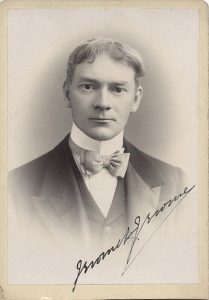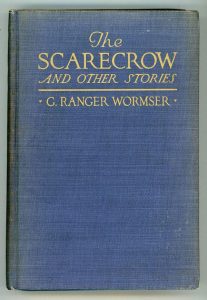“In all weathers you might have seen that hulking old woman, with her vague, staring, reddish face, trudging through the streets…”
A monstrous appetite, a man from the waves, a child’s fractured visions and more. It’s no secret that we like peculiar stories. They don’t have to be from any particular genre, but they have to be darned odd. And whilst there are many fine and well-known classics in the short story form, we also like finding forgotten gems – and wondering why on earth they were forgotten.
So today we highlight six more examples of these, reminding you of our general rules in such articles – the stories should be:
- memorable for their themes, key elements or imagery;
- different from the usual fare in some way, either in style, approach or resolution;
- free of the standard vampires, werewolves, witches, zombies and cthulhoids for a change;
- lodged in one’s memory long after the book is closed.
This time we bent our previous ‘overtly supernatural’ rule occasionally, as we are on the edge of talking early weird fiction rather than standard ghosts and hauntings fare…
NOTE: All of these can be hunted down somewhere on-line, though ‘Nightmare Jack’ can be hard to find, and is probably most easily located by buying the Ash-Tree e-book of Metcalfe’s stories:
https://www.amazon.co.uk/dp/B007KM9P2K/ref=cm_sw_em_r_mt_dp_U_lx-EEbW31Z9PS
The Vernon Lee first came out in Vanitas, which can be found on Project Gutenberg; ‘The Case of Mr Lucraft’ is on Project Gutenberg Australia. Jerome’s ‘Silhouettes’ can be read here:
https://americanliterature.com/author/jerome-k-jerome/short-story/silhouettes
1) ‘NIGHTMARE JACK’ (1925)
John Metcalfe
A long tale of theft and wickedness in Burma, and of final fates in London Town. Dark and fascinating, as it draws you in to the doom of men.
‘ “I shall give you the story as at last he told it to us those ten years back in the upper room of the little, black inn at Shale, whilst the sweat broke and glistened on his face and the horror gathered in his eyes.” ‘
Occasionally difficult in places because of the rendition of Nightmare Jack’s style of speech, but intense and full of eerie references:
‘ “Whilst the wind without raced up against the yellow tide and his face within went grey upon the pillow, that little, whispering man spoke to us—by his frantic hands and eyes as much as by his dying mouth—of the mythos of the Web and Loaf, and the faded terror of the Triple Scum…” ‘
2) ‘THE BIRD IN THE GARDEN’ (1912)
Richard Middleton
Published posthumously, this tale, like the Jerome below, is difficult to settle in any genre. You might pass it off as a weird observational piece, or as a domestic horror story, or as some form of early magical realism. Do give it a try. Middleton, who died young, is unjustly neglected, and the whole posthumous collection The Ghost Ship and Other Stories is a very sound acquisition.
‘It was in the morning after they had just been watered that the plants looked and smelt best, and when the sun shone through the grating and the diamonds were shining and falling through the forest, Toby would tell the baby about the great bird who would one day come flying through the trees—a bird of all colours, ugly and beautiful, with a harsh sweet voice. “And that will be the end of everything,” said Toby, though of course he was only repeating a story his Uncle John had told him.’
3) ‘SILHOUETTES’ (1894)
Jerome K Jerome
How you would classify this very serious piece by Jerome, we couldn’t say, even though we keep re-reading it. It has horror in its nature, but is not supernatural (we don’t think). Suffice to say that it’s odd, disquieting, with scary aspects of a child’s point of view.
‘After what seemed an endless time, we heard the heavy gate unbarred, and quickly clanged to, and footsteps returning on the gravel. Then the door opened again, and my father entered, and behind him a crouching figure that felt its way with its hands as it crept along, as a blind man might. The figure stood up when it reached the middle of the hall, and mopped its eyes with a dirty rag that it carried in its hand; after which it held the rag over the umbrella-stand and wrung it out, as washerwomen wring out clothes, and the dark drippings fell into the tray with a dull, heavy splut.’
4) ‘THE CASE OF MR. LUCRAFT’ (1888)
Walter Besant & James Rice
A most curious story and one of our favourites for its unusual study of human appetite. A warning, though – it is marred in places by its period portrayal, and the dialogue, of a black servant (though he may also not be what he at first seems). Worth knowing about, but certainly with that proviso.
‘I sat down in the nearest chair, and looked round the room. The first thing I remarked was that I could not see the door by which we had been admitted. The room was octagonal, and on every side stood some heavy piece of furniture; a table with glass, a case of bookshelves, a sofa, but no door. My head began to go round as I continued my observations. There was no window either, nor was there any fireplace. Then I felt a sudden giddiness, and I suppose I fell backwards on my chair. It was partly the faintness of hunger, but partly it was the strange room, and that old man glaring at me with his great wolfish eyes.’
An introduction to Walter Besant, by author Matt Wingett, can be found in our archives here:
http://greydogtales.com/blog/portsmouth-humgrummits-and-walter-besant/
5) ‘THE LEGEND OF MADAME KRASINSKA’ (1892)
Vernon Lee
Lee (or Violet Paget, as she was outside her writing) is well enough known, but many of her complex tales are overlooked these days. Whilst her style can be painstaking and dense, she also provides memorable imagery in her works. Sora Lena lurks long after you close the book…
‘ “Do you want to know the story of poor old Sora Lena?” asked Cecchino, taking the sketch from Madame Krasinska’s hand, and looking over it at the charming, eager young face.
‘The sketch might have passed for a caricature; but anyone who had spent so little as a week in Florence those six or seven years ago would have recognised at once that it was merely a faithful portrait. For Sora Lena—more correctly Signora Maddalena—had been for years and years one of the most conspicuous sights of the town. In all weathers you might have seen that hulking old woman, with her vague, staring, reddish face, trudging through the streets or standing before shops, in her extraordinary costume of thirty years ago, her enormous crinoline, on which the silk skirt and ragged petticoat hung limply, her gigantic coal-scuttle bonnet, shawl, prunella boots, and great muff or parasol; one of several outfits, all alike, of that distant period, all alike inexpressibly dirty and tattered. In all weathers you might have seen her stolidly going her way, indifferent to stares and jibes, of which, indeed, there were by this time comparatively few, so familiar had she grown to staring, jibing Florence. In all weathers, but most noticeably in the worst, as if the squalor of mud and rain had an affinity with that sad, draggled, soiled, battered piece of human squalor, that lamentable rag of half-witted misery.’
6) ‘HAUNTED’ (1918)
Gwendolyn Ranger Wormser
From her only known collection, The Scarecrow and Other Stories – a collection which contains a selection of striking tales, and should certainly be more widely circulated. Few these days seem to have even heard of her. Again, a number of her tales come closer to what we might call weird fiction than straight horror.
What the protagonist in ‘Haunted’ is or was, and quite what is his final fate, remains to be seen…
‘He could never remember where he had come from, or what had happened. All that he ever knew was that far out by the nets in the early morning they had come upon him and had brought him in to shore. Naturally, the fishermen had questioned him; but his vagueness, his absolute lack of belief that he had ever been anything before they had snatched him from the waters, had frightened them so that since that day they had left him severely alone. Fishing folk have strange, superstitious ideas about certain things. He had borne the full weight of their credulous awe. Perhaps because he, himself, thought as they thought. That he was something come from the sea, and of the sea, and always belonging to the sea.’
You can find our original Tales that Linger here, with a range of twelve supernatural suggestions, here:
http://greydogtales.com/blog/twelve-tales-which-linger/
We should also mention the members of the Boiled Bones Facebook Group, who suggested other striking ‘lingerers’ which were somewhat unusual, amongst them:
Ralph Adams Cram ‘THE DEAD VALLEY’ (1895)
D K Broster ‘CLAIRVOYANCE’ (1932)
David Grinnell ‘THE RAG THING’ (1951)
A E D Smith ‘THE COAT’ (1952)
If you don’t know these already, all four should be of great interest to enthusiasts of strange stories.
https://www.facebook.com/groups/213679486368857/



